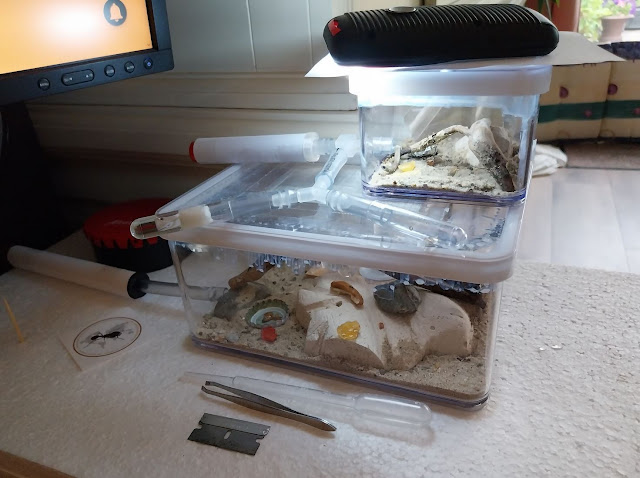Yessss, Messor Barbarus (Harvester Ants) arrived and was immediately coupled to the larger outworld with all kinds of things to eat in it so they can build up energy after the mail trip of about 12 hours.
The Lasius Niger setup is on top.
There are some seeds in the tube and the mini seeds package will arrive tomorrow so they will be fine until then.
Messor barbarus, commonly known as the harvester ant, is a fascinating insect species that inhabits various regions of Europe and Northern Africa. These ants have earned their name due to their remarkable ability to harvest and store seeds, which forms a significant part of their diet. Let's take a closer look at the remarkable characteristics and behaviors of Messor barbarus.
One of the most distinctive features of Messor barbarus is their impressive size. They are relatively large ants, with workers measuring around 10 to 15 millimeters in length. Their bodies are predominantly black, although some individuals may have reddish or brownish hues. These ants have robust mandibles that allow them to cut through tough vegetation and collect seeds effectively.
Harvester ants, like Messor barbarus, are known for their remarkable seed-harvesting behavior. They have developed a highly efficient system where workers venture out of their nests in search of seeds from various plant species. Once a worker locates a suitable seed source, it uses its powerful mandibles to cut the seeds from the plants. Messor barbarus ants are particularly known for their ability to harvest a diverse range of seeds, including grasses, wildflowers, and even small cereal grains.
After collecting the seeds, the industrious harvester ants carry them back to their underground nests. Here, they meticulously sort and store the seeds in specialized chambers called granaries. The granaries serve multiple purposes. Firstly, they protect the seeds from external threats such as parasites, mold, and moisture. Secondly, they ensure a steady supply of food for the ant colony during lean periods, such as winter when seed availability may be scarce. The stored seeds can remain viable for an extended period, providing sustenance for the colony throughout the year.
Messor barbarus colonies exhibit an intriguing social structure, with various castes serving specific roles. The worker ants, responsible for foraging and seed collection, are the backbone of the colony. The queens, larger in size, lay eggs and maintain the population. The males, much smaller and less numerous, have the sole purpose of mating with the queens.
These ants display remarkable coordination and communication within their colonies. They use pheromones to communicate information about food sources, nest locations, and potential dangers. By following scent trails left by their fellow workers, Messor barbarus ants can efficiently navigate to and from their nest, maximizing their foraging efficiency.
In addition to their ecological significance as seed dispersers, Messor barbarus ants also play a crucial role in soil aeration and nutrient cycling. Their foraging activities and nest-building behavior contribute to the health and fertility of the ecosystem they inhabit.
Messor barbarus, the harvester ant, exemplifies the intricate wonders of the natural world. Their remarkable seed-harvesting abilities, cooperative behavior, and ecological importance make them a fascinating species to study and appreciate.

Comments
Post a Comment